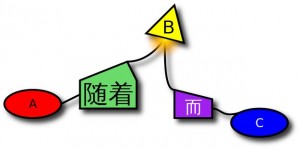随着 ... 而 in Mandarin: with, as
 English sentences with structures like “as A does X, B does Y” can be quite tricky to translate into Mandarin.
English sentences with structures like “as A does X, B does Y” can be quite tricky to translate into Mandarin.
They usually contain ‘as’ or ‘with’, and express related situations or causal relationships.
The Mandarin 随着 … 而 structure is very useful for expressing this.
The general format is like this:
[NP] 随着 [NP] 而 [VP]
(NP is 'noun phrase', VP is 'verb phrase')The difficulty is that it doesn’t mirror the English equivalent exactly. In English, the causal event can be expressed with a verb or a noun, whereas in this Mandarin structure it can only be expressed with a noun. For example, in English it might be:
“As global warming increases, sea levels get higher and higher.”
But this would have to be rendered with a noun in the Mandarin 随着 structure:
海面随着全球变暖的增长而越来越高。
i.e. “With the increase of global warming, sea levels get higher and higher.”
More examples:
韩国随着朝鲜的外患而在南边集结军队。 Hánguó suízhe cháoxiǎn de wài huàn ér zài biānjiè fùjìn jíjié jūnduì. “As North Korea displays aggression, South Korea concentrates its forces near the border.”
学习语言随着Skype的发行而变得更容易。 Xuéxí yǔyán suízhe Skype de fāxíng ér biàn děi gèng róngyì. “With the release of Skype, studying languages has become easier.”
树上的叶子随着冬天的到来而掉下去。 Shù shàng de yèzi suízhe dōngtiān de dàolái ér diàoxià qù. “With the arrival of winter, the leaves on the trees fall down.”
我的生活随着时间的推移而变得越来越坏。 Wǒ de shēnghuó suízhe shíjiān de tuīyí ér biàn děi yuèláiyuè huài. “As time goes on, my life gets worse and worse.”
我随着他对Justin Bieber的兴趣而不能爱他。 Wǒ suízhe tā duì Justin Bieber de xìngqu ér jiù bù néng ài tā. “With his interest in Justin Bieber, I just couldn’t love him.”
